Abstract
Mexico holds significant potential for wind energy development, owing to its strategic geographic location and extensive coastlines. This review article systematically explores the technical, environmental, and economic aspects of wind energy in five different climatic zones in Mexico, reviewing potential zones for wind energy development, with the focus on the key case studies, ongoing project, and wind power performance metrics. It also critically examines the key challenges and opportunities within Mexico’s wind energy portfolio, with a focus on social, economic, environmental, and regulatory dimensions that influence the sector’s development and long-term sustainability. The results indicate that Oaxaca leads Mexico’s onshore wind potential with a power density of 761 W/m2, followed by strong resources in Tamaulipas and Baja California, where wind speeds exceed 6 m/s. For offshore wind potential, Isthmus of Tehuantepec demonstrates outstanding offshore potential, with wind power densities exceeding 1000 W/m2 and wind speeds above 8 m/s. Major challenges include inconsistent or unclear governmental policies regarding renewable energy incentives, regulatory uncertainties, and social resistance from local communities concerned about environmental impacts and land use. These obstacles underline the need for integrated, transparent policies and inclusive engagement strategies to carry out the full potential of wind energy in Mexico.
1. Introduction
1.1. Research Context and Motives
The growing worldwide need for energy, environmental necessity against using fossil fuels, and the climate action urgency collectively have accelerated the focus on renewable energy sources [1,2,3]. However, a major issue with renewable energy sources is intermittency, which impacts the reliability of the power availability and must be addressed [4,5]. Wind power is regarded as a promising clean energy source for both offshore and onshore urban environments [6,7]. Wind energy, in comparison to other clean and renewable energy sources, offers a multitude of advantages, some of which are low environmental impact, consistent availability, and effectiveness in reducing pollution [8,9], and relatively low long-term operating costs since they do not rely on fuel prices, which ultimately can lead to greater stability in energy prices [10,11].
Global wind power capacity saw significant growth in 2023, with 116.6 GW of new installations—a 50% increase from 2022 [12]. This brought the total installed capacity to 1021 GW, a 13% rise year-over-year. The leading markets for new wind power in 2023 were China, the US, Brazil, Germany, and India, with India replacing Sweden in the top five compared to 2022 [12]. The top five countries for total installed wind power—China, the US, Germany, India, and Spainand accounted for 72% of global capacity [12,13]. Wind power can be broadly categorized into onshore and offshore wind farms, depending on the geographical location [14,15]. Over the past 15 years, the globally installed capacity of both onshore and offshore wind power has increased continuously as highlighted in Figure 1a,b.
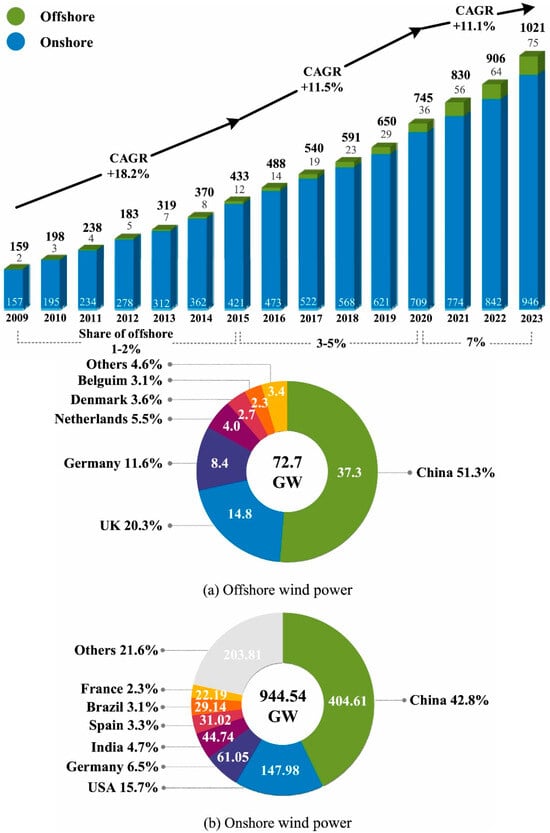
Figure 1.
(a) Development of worldwide wind power installation; (b) Global installed wind power capacity [14,15]. Reproduced with permission © Elsevier, 2025, License number 6006570423966.
Globally, 32 countries generated more than a tenth of their electricity from wind power. Denmark had the highest share of wind energy generation in the electricity mix at 58% [16]. Ireland had the second highest share at 36%. The Scandinavian countries of Sweden, Denmark, Norway and Finland lead the world in wind generation per capita [16,17]. In the Latin-American market, Brazil leads the wind energy production sector. The South American country is the leading wind producer, with a wind capacity of 16 GW and an annual generation of 42,373 TWh, representing 9.5% of the national total consumption in 2022 [18]. In the case of Mexico, it is expected to become a leader in the wind sector, with an annual electricity production of 20.89 TWh, compared with the total electricity consumption of 281.57 TWh [18]. Regarding the global offshore projects, the amount of capacity installed in 2023 represents the fourth largest annual installed capacity ever (with only the prior three years higher) [19]. The year 2021 was exceptional because many projects in China sought to qualify for government-sponsored feed-in tariff incentives that expired at the end of 2021 [19]. Continued growth is anticipated in the following years, driven by new implemented policies in several countries around the world in response to the escalating crisis and the challenges associated with the fossil fuel crisis [20,21]. Many countries have intensified their efforts to develop large-scale wind farms, both onshore and offshore, supported by concrete policy initiatives. Consequently, short-term growth is also expected to be significant.
1.2. Contributions and Innovations of the Current Study
Over the last few years, Uncovering Mexico’s offshore wind potential is of strategic importance, as the country’s geographic position enables it to serve as a key nearshoring energy provider—playing a vital role in supporting the sustainable energy demands of North America’s ongoing economic growth [22]. However, Mexico has made limited progress in offshore wind policy development, initial studies—focused on areas like the Gulf of Mexico [23], Oaxaca’s coast [24], and Tehuantepec Gulf [25] have assessed production potential and LCOE. Meza-Carreto et al. [26] evaluated Mexico’s offshore wind energy potential over a period (2000–2018) using the Weather Research and Forecasting model and CMIP data. The analysis highlights three promising regions for future offshore wind development: the northwestern coast of Yucatán, the northern coast of Tamaulipas, and the Gulf of Tehuantepec. It can be indicated that the previously mentioned efforts remain regional and lack a comprehensive evaluation of the country’s full offshore capacity, competitiveness, and deployment challenges. A precise assessment of Mexico’s offshore wind potential is essential to identify high-yield sites, guide technology selection suited to local conditions, inform effective policy and incentives, and ensure reliable grid integration for sustainable sector development. This review article explores the technical, environmental, and economic aspects of wind energy in five different climatic zones in Mexico, reviewing potential zones for wind energy development, with the focus on the key case studies, project examples, and performance metrics. Figure 2 presents a flowchart outlining the overall structure of the literature review conducted in this study. This pioneering research is to apply the PRISMA systematic survey method to Mexican wind energy portfolio, offering a national quantitative comparison of 68 core studies published between 2018 and 2025. It develops a “method–context” matching matrix, addressing a critical gap in cross-method comprehensive evaluation and identifies existing research gaps and provides concrete directions for future inquiry, along with practical recommendations tailored for policymakers, researchers, and industry practitioners. The main objectives of this study are listed as follows:
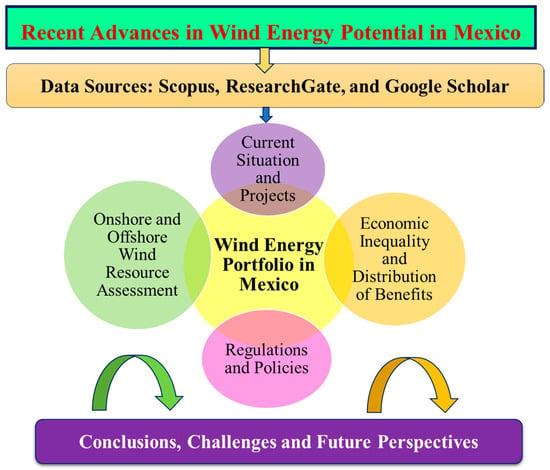
Figure 2.
Flowchart of framework and organization of the literature research.
- To comprehensively assess Mexico’s onshore and offshore wind energy potential and delineate priority zones suitable for the technical deployment of wind turbines.
- To analyze existing literature on the current state of wind development in Mexico, with a focus on technological trends and exiting projects.
- To identify key barriers and propose strategic recommendations for the effective integration of wind energy into Mexico’s national energy system.
2. Methods and Materials
This review follows a systematic review method guided by the step-by-step methodology outlined by Munn et al. [27]. A systematic scoping review is a literature survey approach that maps existing evidence on a broad topic to identify key concepts, research gaps, and the overall scope of the field [28,29]. It provides a comprehensive overview rather than answering a narrowly defined researching question. This systematic scoping employs a structured methodology to investigate the current sustainability challenges associated with onshore and offshore wind energy development in the resources assessment and techno-economic context of five different climatic zones in Mexico. The process involved clearly defining the research focus, systematically searching the literature, selecting relevant studies, and synthesizing the key insights. The literature was sourced from five primary databases: Scopus, ResearchGate, Google Scholar, websites of global wind energy institutions and associations such as Global Wind Energy Council. Google Scholar was specifically included to ensure coverage of gray literature essential for rapid scoping reviews—as well as scholarly works published across local, regional, national, and international platforms relevant to the study’s focus. Moreover, important periodicals in Mexico empathizing on wind energy like Energía Hoy and Global Energy, are involved. Government platforms such as SENER (Secretaría de Energía) and CRE (Comisión Reguladora de Energía) are also utilized to provide official data, regulations, and ongoing national projects. These sources serve as an access to a wide range of academic materials, including theses, dissertations, and patents via various fields, with relevance to the prosed study. Scopus was selected as well, given its status as the world’s largest abstract and citation database for peer-reviewed literature, serving to validate and enhance the reliability of the searches conducted in the other databases. The literature review was conducted between November 2018 and January 2025, beginning with a broad search on Google Scholar using the phrase ‘sustainability challenges of national wind energy generation in Mexico using important key words and data outcomes such as Wind energy resources; Wind power density; Mexico; Regulatory framework; Systematic review. This focus was chosen in light of the identify the recent research development and ongoing projects in offshore and onshore wind energy in Mexico zones, widely promoted as a clean and sustainable solution. Boolean operators ‘OR’ and ‘AND’ were set to refine keyword combinations during the searching process.es Following duplicate removal and title and abstract screening based on defined inclusion and exclusion criteria, 40 studies in English or Spanish were deemed eligible for review. Windographer is also adapted for providing monthly wind resource data across Mexico by processing time-series liberality from meteorological wind towers systems. It considers the time series of wind measurements typically hourly data for one complete year from 1 January 2023 to 31 December 2023, taken from Refs. [30,31]. The PRISMA flow diagram effectively illustrates the progression of information through each stage of a systematic review, from identification and screening to inclusion [30]. It enhances transparency by visually documenting how studies were selected, excluded, or retained based on eligibility criteria. Figure 3 highlights the PRISMA flow diagram of information through the different phases of a systematic review. It maps out the number of records of studies and reports identified, included and excluded, and the reasons for exclusions. Considering the PRISMA methodology, the in-depth preliminary classification phase immediately after the retrieval of records from the selected databases is a crucial step in constructing the review. It organizes studies thematically according to recurring themes and research areas, reducing overlap and duplication and enhancing analytical clarity. Because wind energy research typically spans technical, environmental, social, political, and economical aspects. This a priori classification enables the identification of the most widely discussed themes and an assessment of their relative presence within the literature. By grouping works under these recurring themes, the review gains greater depth and coherence, resulting in a concluding synthesis that is not only comprehensive but also reveals prevailing trends, methodological preferences, and knowledge gaps. This enhances the review’s credibility, as it goes beyond a narrowing down of eligible studies to a more accurate reading of research patterns in this Mexican national mission.
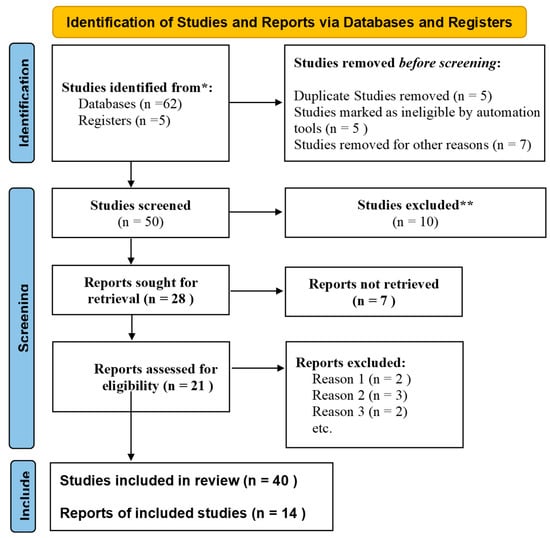
Figure 3.
PRISMA flow diagram of the literature research.
3. Wind Resources Assessment in Mexico
Mexico is well-positioned to emerge as a leader in the clean energy sector, thanks to its exceptional renewable energy potential and the affordability of renewable power generation. Accelerating the expansion of renewable energy in the country could attract significant investment, enhance energy access, lower consumer costs, and, combined with other measures, strengthen the reliability and resilience of the Mexican power system [31,32]. The national wind capacity potential is estimated at 3699 GW. This potential capacity could generate 5759 TWh/yr, 15 times the 365 TWh estimated demand for Mexico in 2024. As part of Mexico’s Nationally Determined Contributions (NDC), the Mexican government has outlined targets for emission reduction, including a commitment to generate 43% of its energy from renewable sources by 2030 [33,34].
3.1. Onshore Wind Resources
Figure 4 and Figure 5 provide an overview of the onshore wind energy potential distribution in Mexico. Figure 4 shows offshore wind resource potential along Mexico’s coasts, with red areas indicating the highest energy density (>250 W/m2), whereas Figure 5 displays the onshore mean wind velocity in Mexico. Key high-potential six zones include (1) Isthmus of Tehuantepec (Oaxaca), (2) Tamaulipas, (3) Nuevo Leon, (4) Coahuila, (5) Baja California, (6) Baja California Sur. These areas are ideal for offshore wind development due to strong and consistent wind patterns [33,34,35]. The color gradient helps identify regions suitable for large-scale renewable energy projects. From Figure 4 and Figure 5, it is possible to highlight some areas with great potential for the development of windy projects. The first one is the Isthmus of Tehuantepec, Oaxaca, located in the south of the country, near the Pacific Coast. This region has been of historical importance for wind projects in the country since the first wind farm in Mexico was installed in locations [33,34,35]. The North of the country also possesses a high potential for wind energy projects. The contiguous states of Tamaulipas (next to the Gulf of Mexico), Nuevo Leon and Coahuila have shown good potential since the 10% of the windiest areas of these states exhibit a mean Power Density over 300 W/m2 and a mean Wind Speed over 6 m/s [35]. Another area that shows great potential for onshore wind projects is the Baja California Peninsula, which includes the states of Baja California and Baja California Sur. The available wind energy resources in these states could generate wind energy for around 12% of small urban communities in Baja California; meanwhile in Baja California Sur, the electric power generation could electrify almost 25% of small urban areas [36]. A summary of the Wind Power Density and mean Wind Speed in the mentioned states is shown in Table 1.
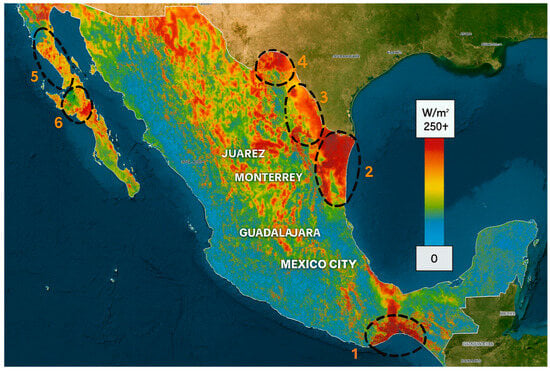
Figure 4.
Onshore wind power density distribution in Mexico: (1) Isthmus of Tehuant Epec (Oaxaca), (2) Tamaulipas, (3) Nuevo Leon, (4) Coahuila, (5) Baja California, (6) Baja California Sur [34,35].
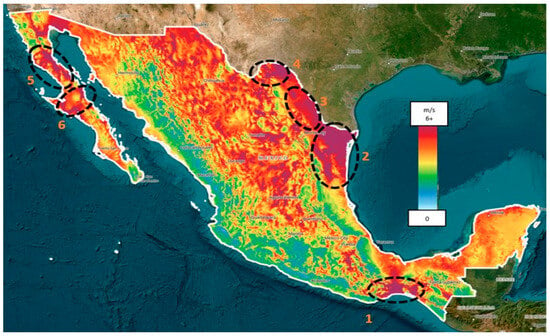
Figure 5.
Onshore mean wind velocity in Mexico: (1) Isthmus of TehuantEpec (Oaxaca), (2) Tamaulipas, (3) Nuevo Leon, (4) Coahuila, (5) Baja California, (6) BajaCalifornia Sur [34,35].

Table 1.
Onshore wind power resources assessment of various zones in Mexico.
3.2. Offshore Wind Resources
Figure 6 and Figure 7 show the offshore wind energy potential in six zones in Mexico in terms of the Wind Power Density and mean Wind Speed at 100 m, including offshore values at a maximum distance of 150 km from the cost. Using the software Windo-Grapher Version 5.3.10, more detailed information about the previously mentioned areas was extracted. The ERA5 reanalysis dataset was used to estimate potential at a 100 m altitude. A total of 16 sites were chosen to be evaluated. The corresponding information of those sites is shown in Table 2. As in the case of onshore resources, the Isthmus of Tehuantepec, Oaxaca is one of the areas with great potential for offshore wind energy projects, showing a vast area with an estimated wind power density and wind mean velocity over 500 W/m2 and 10 m/s, respectively. Another zone that also exhibits good offshore potential is the coast of Tamaulipas in northern Mexico, and Baja California. Results about the potential of offshore projects in these areas have already been reported indicating good results [24,36,37]. The findings in Figure 6 and Figure 7 also manifested, two new potential zones will be analyzed: the north of Yucatan Peninsula and the coast of Veracruz. For the case of the first region, it has been found that average wind speeds are between 8 m/s and 9 m/s and capacity factors (CFs) between 50% and 55% for selected wind turbine models [23]. Moreover, a potential offshore wind farm in this area has already been proposed [38]. The results overlay demonstrated that the model effectively captures the diurnal, monthly, and seasonal fluctuations in wind speed, showing strong agreement within the wind speed range relevant for wind farm applications.
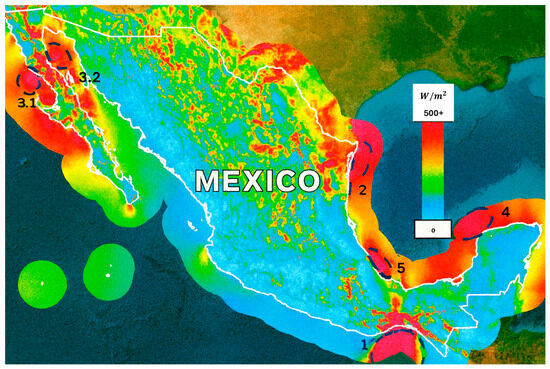
Figure 6.
Offshore wind power density distribution in Mexico: (1) Isthmus of Tehuantepec (Oaxaca), (2) Tamaulipas, (3) Baja California, (4) Yucatan Peninsula, (5) Veracruz [34,35].
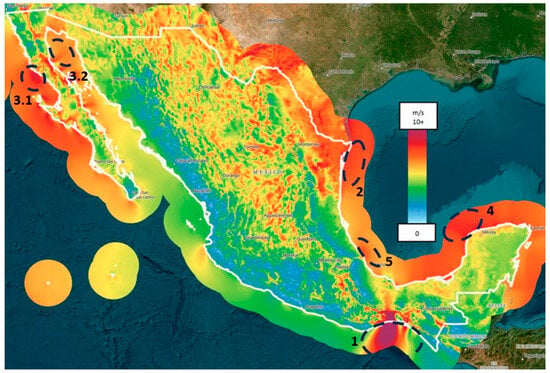
Figure 7.
Onshore mean wind velocity in Mexico: (1) Isthmus of Tehuantepec (Oaxaca), (2) Tamaulipas, (3) Baja California, (4) Yucatan Peninsula, (5) Veracruz [34,35].

Table 2.
Geographical coordinates of selected offshore sites in Mexico.
The values for the Mean Wind Speed and Mean Power Density are also shown in Figure 8. As in the case of on-shore analysis, the states of Oaxaca, Tamaulipas, and Baja California showed good potential for offshore projects. The sites identified as Oax 1 and Oax 2 showed an outstanding potential since the reported values of MWS and WPD are over 8 m/s and 1000 W/m2, respectively. These WPD values are by far the highest recorded of the selected sites of the study, showing the great potential of the zone for both onshore and offshore projects. It is interesting to point out the case of Oax 3, which is located near the previously discussed sites, but shows much less potential for offshore projects.
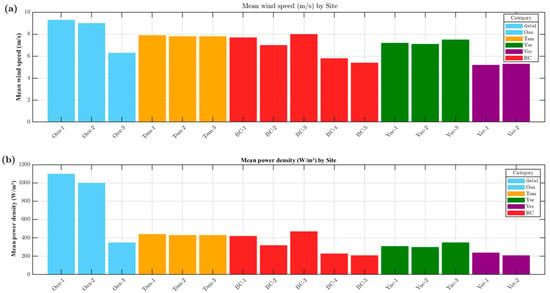
Figure 8.
(a) Mean Wind Speed (MWS), (b) Mean Power Density (MPD) for the selected offshore wind sites.
In a particular location as a case study, Figure 9 depicts the variations in the Monthly Mean Wind Speed (MMWS) for Isthmus of Tehuatepec (Oaxaca) offshore zone. From Figure 9a can be seen that the highest values of MMWS take place during the months of January and December, while the lowest are during June. The variation between maximum and minimum values are considerably high. Considering the site Oax 1, the maximum recorded value (near 13 m/s) doubles the minimum one. Regarding MDP, the values of the three sites tend to show similar tendencies and relatively small variations. In the case of Tamaulipas, the three sites examined showed similar characteristics, indicating fair potential for possible offshore installations. The WPD of the sites is slightly above 400 W/m2, while the MWS is just below the 8 m/s mark. Also, the three examined sites showed similar tendencies of MMWS and MDP, indicating small variations in the behavior of the wind speed. For the remainder states, the only site that could have potential for windy projects is Yuc, whose values of MWS and MPW are 7.538 m/s and 362 W/m2, respectively. Since the obtained values are below those shown by sites with good potential, more studies are necessary to decide the viability of a possible offshore project in such optimal off-shore zone.
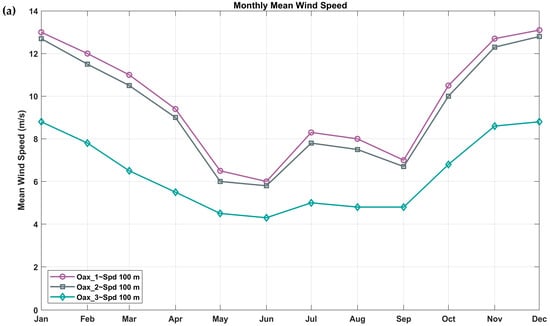
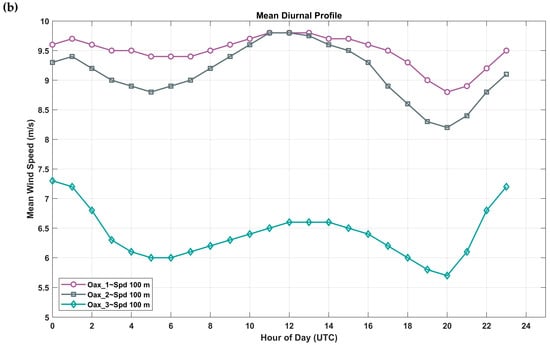
Figure 9.
(a) Monthly mean wind speed (MMWS); (b) Hourly mean wind speed for Isthmus of Tehuatepec (Oaxaca) offshore wind zone.
4. Current Situation and Ongoing Projects of Wind Energy
According to the Mexican Wind Energy Association [39], in 2024 the installed Wind Energy capacity increased 96 MW, reaching a total of 7413 MW, which represented an increase of 1.3% compared to 2022. The amount of electric energy generated by Wind Energy plants surpassed 20,000 GWh, which represents 5.98% of the total electric generation in the country. In addition, the number of direct jobs related to the Wind Energy sector reached 9500 [39]. Also, this sector con- tributed to avoiding the emission of around 9 million tons of CO2. Currently, 71 wind farms are operating in the country, distributed in 15 states. The 7413 MW produced represented 8.26% of the total electric installed capacity in Mexico. The three states with the highest installed capacity are Oaxaca (2758 MW), Tamaulipas (1715 MW) and Nuevo Leon (793 MW).
Under its Energy Transition Law, the country aims to generate half of its electricity using clean energy sources by 2034. This goal is supported by the requirements of the Clean Energy certificate (CEC) and long- term electricity auctions. The transition is seen as crucial for enhancing energy security, attracting investments, and promoting economic growth. It is also essential for addressing climate change and reducing greenhouse gas emissions [40]. In March 2024, Sempra Infrastructure placed a 319 MW order for the Cimarron wind farm in Tecate, in the state of Baja California, Mexico. This is the third phase of the Energia Sierra Juarez Wind Complex, which will have a total installed capacity of 582 MW. This complex will supply renewable energy to the City of Santa Clara, California [41,42]. However, the current political climate has introduced challenges. The present administration has taken steps that discourage private investment in renewable energy projects, arguing that such investments perpetuate social injustices [42]. This has led to stagnation in the growth of renewable energy, particularly wind and solar, which had previously seen significant investment and development [43]. For example, in February 2024, the Mexican Wind Energy Association announced USD 5.8 billion in investment, which remains stalled due to regulatory hurdles affecting 35 wind power generation farms in the country. The association also reveals that Mexican Energetic Regulator Council has held up permits for seven completed plants, totaling 800 MW of installed capacity, along with 28 parks at various development stages, collectively amounting to 5000 MW [44]. In Tamaulipas, The State Energy Commission suspended at least 30 wind projects due to a lack of transmission lines from the Electric Federal Council. Thus, to boost generation, the government announced an investment of approximately MXN 8 billion in developing the necessary infrastructure.
5. Challenges and Opportunities of Mexican Wind Energy Portfolio
Despite the potential for developing wind energy projects in Mexico, the country has faced several challenges that have hindered the advancement of these technologies. The historical drawbacks have been related to the rejection of local communities and environmental concerns. In recent years, unclear politics about the establishment of renewable energy projects have also played a crucial role.
5.1. Social Conflicts and Community Opposition
Besides having a great potential for wind energy projects, Isthmus of Tehuantepec (Oaxaca) is home to numerous indigenous communities that rely on the land to support a subsistence way of life [45]. In these communities, there is a communal land ownership system known as ejido, which has been used since 1917. This system states that a group of peasants or ejidatarios had the perpetual rights of a specific area for agricultural purposes but without the right to sell [46]. Previously, the Mexican Constitution was reformed, and the ejido was allowed to be transformed into individual rights, which allow them to be sold, rented, or mortgaged [47]. However, any order, lease, or conveyance of land must be made with the consent of the community through an Assembly [45,48]. It has been reported that through the manipulation of these mechanisms, some companies have obtained the rights over lands for the development of wind energy projects [49,50], a situation that has led to conflicts in the region related to the use of the land. In 2011, the development of 102 wind turbine project in the community of Alvaro Obregon in Isthmus of Tehuantepec divided the members of the population into two factions: the Communitarians, who oppose the wind project and advocate for Indigenous autonomy, and the Constitutionalists, who support the project and the political order [51]. This division has been intensified by the involvement of state police and private security forces, which have been used to suppress dissent and maintain control over the area After two years of conflict, the project was finally turned down [52]. The available data warrant emphasizes that the positioning of wind potential in Oaxaca is a direct result of the uniqueness of its wind system. The Isthmus of Tehuantepec records average wind speeds exceeding 8–10 m/s, accompanied by higher capacity factors than the rest of Mexico. This technical superiority has led to the state being prioritized by industry and academia as a preferred research and development arena. However, this geographic concentration may lead to biased interpretation and evaluation. Political, social, and regulatory factors in Oaxaca—from land tenure disputes, community acceptance, and political uncertainty might constrain scalability and limit the generalizability of results to the rest of the country. Accordingly, our study treats Oaxaca as a “reference case” that simultaneously reveals the technical opportunities and governance challenges inherent in large-scale wind energy deployment, rather than as the sole representative of Mexico’s wind potential. The results from this region are therefore read as a comparative and normative framework, rather than as a substitute for existing regional variations.
5.2. Economic Inequality and Benefit Distribution
Wind energy projects often lead to significant economic benefits; however, these are frequently concentrated among a small number of elites, landowners, and selected workers. For instance, while some individuals may receive substantial lease payments for land used in wind farms, many local residents see little to no economic gain. Re- ports indicate that lease payments in Oaxaca can be as low as $125 per hectare per year, compared to $3000 to $5000 per year in the United States [53].
The economic benefits generated by wind energy projects are frequently concentrated among a small number of stakeholders, such as transnational corporations and local elites, while the broader community sees little to no financial gain [54]. This contributes to a deepening rift between different socioeconomic classes. While wind energy projects may create jobs, these positions are often temporary, low-paying, and do not provide sustainable economic security for local populations [54]. The promise of employment can lead to exploitation, where locals are pressured into accepting unfavorable terms due to economic desperation [55]. The establishment of wind farms can disrupt traditional agricultural practices and local economies too. Wind energy projects often require significant land areas, which can lead to the displacement of agricultural activities [45]. People form indigenous communities that rely on farming for their livelihood could find their land taken for the development of wind energy farms, a situation that changes their traditional agricultural practices and eventually translates into opposition to these kinds of projects. Also, the conversion of land for wind energy can threaten food security in local communities. As agricultural land is converted for energy production, the availability of land for growing food diminishes, potentially leading to an increase in food scarcity and reliance on external food sources.
5.3. Environmental Implications
Challenges related to environmental concerns in the context of wind energy projects in Mexico, particularly in the Isthmus of Tehuantepec, are significant and diverse. The construction and operation of wind farms can lead to substantial alterations of the local ecosystems. This includes habitat destruction due to land clearing for turbine installation and infrastructure development, which can disrupt local flora and fauna [56]. It was reported that the construction of wind parks has led to environmental degradation, including oil leaks from turbines that can contaminate soil and water sources, adversely affecting agriculture and livestock [56]. Wind energy projects may represent a threat to local wildlife, particularly birds and bats, which may collide with turbine blades [57,58]. The Isthmus of Tehuantepec is home to diverse species, and the introduction of wind farms can disrupt migratory patterns and local populations [54]. The potential of increasing the mortality rates among protected species raises significant environmental concerns.
The development of wind farms often involves the use of non-porous materials for roads and turbine foundations, which can affect local water tables and intensify existing water scarcity issues in the region [45]. The communities have expressed their concerns about the potential problems related to wind energy development, particularly in an area where water security is a pressing issue. The lack of Environmental Impact Assessments (EIAs) in the context of wind energy projects has also been a factor for the raise of environmental concerns [56]. The absence of comprehensive EIAs can lead to inadequate regulatory frameworks that fail to address the specific environmental and social impacts of wind energy projects. This can result in unregulated development that does not consider local ecological and community needs.
5.4. Regulations and Policies
The regulatory environment governing wind energy in Mexico has been marked by inconsistency and frequent changes, particularly following the 2013 energy reform. This reform was initially planned to promote investments from the private sector in the energy market, but it has faced several political drawbacks that have affected its implementation. The current administration has shown a preference for state-owned enterprises, which has created uncertainty for private investors and developers [43]. Wind energy planning has often been characterized by a top-down approach, where federal authorities make decisions with minimal input from local and regional stakeholders. This lack of local participation has led to conflicts and resistance from communities, particularly indigenous groups who feel their rights and interests are not considered. The institutional capacity to manage and regulate wind energy projects is often inadequate.
There is a lack of coordination among various levels of government (federal, state, and municipal), which affects the authorization of projects and promotes delays [56]. The political and economic interests tied to fossil fuels create resistance to transitioning towards renewable energy. This resistance is often rooted in concerns about job losses in traditional energy sectors and the perceived threat to energy sovereignty. The administration of President Andres Manuel Lopez Obrador (2018–2024), referred to as the” Fourth Transformation” (4T), prioritized the use of fossil fuels over renewable energy sources. This policy aims to strengthen state-owned companies, like the Electric Federal Council, which are heavily involved in the production and distribution of fossil fuels. The government has sought to regain control of the electricity market, promoting fossil fuel generation, even at the expense of efficiency and environmental considerations [44].
6. Future Prospective of Mexican Wind Energy Portfolio
Mexico’s wind energy sector holds remarkable potential, but its future success depends on overcoming persistent structural and socio-political challenges. The future trends for wind energy implementation in Mexico require a multifaceted approach to tackle existing challenges. Firstly, regulatory stability and transparent energy policies are essential to attract sustained investment and reduce uncertainty in ongoing projects. Secondly, strengthening storage capacity and grid infrastructure might be critical to managing intermittency and reliably. integrate growing wind capacity. Thirdly, fostering local manufacturing and workforce development can reduce dependency on imports while promoting socioeconomic benefits. Fourthly, stronger community engagement strategies are required to mitigate social resistance and ensure equitable distribution of project benefits. Finally, long-term success will depend on coupling wind projects with complementing other renewable energy systems and digital technologies to maximize efficiency and resilience of Mexico’s energy transition. From other social aspects, strengthening community engagement is essential, as mistrust arising from land disputes and unequal benefit distribution has fueled opposition in regions like Oaxaca. Future projects must ensure equitable economic returns, moving beyond elite capture toward fairer lease agreements and long-term local employment. Environmental concerns demand stricter enforcement of impact assessments and ecosystem-sensitive planning to minimize biodiversity loss and water resource stress. At the policy level, a consistent, transparent, and participatory regulatory framework is urgently needed to reduce uncertainty and depoliticize energy governance. Greater coordination across state, federal, and municipal institutions could reduce costly delays and accelerate project authorization. International investment and technology transfer might be vital, however only if accompanied by inclusive governance that addresses both indigenous rights and environmental stewardship.
7. Conclusions
Wind energy represents a highly promising path toward a more sustainable energy future for Mexico. The geographical diversity of the country offers different areas with high wind potential that could help the country to reach its goal of increasing its production of energy from renewable sources. This study presents a critical review of resource assessment and the technical viability of harnessing offshore and onshore wind energy for electricity generation in Mexico, contributing to the advancement of renewable energy research and national decarbonization efforts. The review evaluates and compares prospective areas for wind energy development, emphasizing key case studies, current projects, and performance indicators for wind power generation. It also explores the sector’s key challenges and prospects, considering social, economic, environmental, and regulatory influences on its future growth. The reviewed results indicate that Oaxaca leads Mexico’s onshore wind potential with a power density of 761 W/m2, followed by strong resources in Tamaulipas and Baja California, where wind speeds exceed 6 m/s. For offshore wind potential, Isthmus of Tehuantepec demonstrates outstanding offshore potential, with wind power densities exceeding 1000 W/m2 and wind speeds above 8 m/s. The ongoing projects indicate Mexico is increasingly harnessing wind energy, especially in Oaxaca, to support sustainability goals and diversify its energy mix. However, the current landscape reveals that much of this potential remains unexploited. Key barriers, such as ambiguous governmental support, policy reversals, and opposition from local communities, continue to delay the progress of new projects. Moreover, it is necessary to establish a stable and transparent policy framework that provides long-term support for clean energy initiatives. This change will give more confidence to potential stakeholders to invest in wind energy developments in the country. Equally important is fostering trust and collaboration with local populations through transparent communication, benefit-sharing mechanisms, and community participation in project planning. Overcoming these challenges will be essential to unlock the full potential of wind energy.
Author Contributions
Conceptualization, U.C.B., M.E.Z., and S.R.; methodology, U.C.B., M.E.Z., and S.R.; validation, M.E.Z. and M.G.; formal analysis, U.C.B., M.E.Z., M.G., and S.R.; investigation, U.C.B., M.E.Z., and S.R.; data curation, U.C.B., M.E.Z., and M.G.; writing—original draft preparation, U.C.B., M.E.Z., and M.G.; writing—review and editing, M.E.Z. and S.R.; visualization, M.G.; supervision, S.R.; project administration, S.R. All authors have read and agreed to the published version of the manuscript.
Funding
The research received no external funding.
Institutional Review Board Statement
Not applicable.
Informed Consent Statement
Not Applicable.
Data Availability Statement
The data presented in this study are available upon substantiated request from the corresponding author.
Acknowledgments
The authors express his acknowledgements to Interdisciplinary Research Center for Sustainable Energy systems (IRC-SES), King Fahd University of Petroleum & Minerals (KFUPM), Dhahran, Saudi Arabia.
Conflicts of Interest
The author declares no conflicts of interest.
References
- Currie, G.; Behrens, E.; Bolitho, S.; Coen, M.; Wilson, T. Green Hydrogen Driven by Wind and Solar—An Australian Case Study. Wind 2024, 4, 111–134. [Google Scholar] [CrossRef]
- Zayed, M.E.; Irshad, K.; Rehman, S.; Kabeel, A.E.; El Hadi Attia, M.; Abdelrazik, A.S.; Khelifa, A.; Abdelgaied, M.; Mohandes, M.A.; Algarni, S.; et al. Performance Appraisal of a Modified Finned Solar Air Collector Thermally Assisted by a Smart-Switchable Cover for Constant Outlet Hot Air Temperature: Numerical Investigation. Energy Nexus 2025, 19, 100529. [Google Scholar] [CrossRef]
- Shboul, B.; Zayed, M.E.; Abdelrazik, A.S.; Alrbai, M.; Odat, A.-S.; Almomani, F. Exergoeconomic and Environmental Impact Assessment of a Semi-Scale Office with Solar Chimney and Evaporative Cooling Tower for Sustainable Space Cooling and Air Ventilation. Energy Convers. Manag. X 2025, 27, 101191. [Google Scholar] [CrossRef]
- Zhang, L.; Zhang, R.; Zhang, X.; Xie, B.; Chen, X. China’s Development Path for Intermittent Renewable Energy Power Generation: The Influence of Diffusion Factors. Chin. J. Popul. Resour. Environ. 2025, 23, 193–204. [Google Scholar] [CrossRef]
- Rehman, S.; Menesy, A.S.; Zayed, M.E.; Zaery, M.; Al-Shaikhi, A.; Mohandes, M.A.; Irshad, K.; Kassas, M.; Abido, M.A. Synergistic Sizing and Energy Management Strategy of Combined Offshore Wind with Solar Floating Pv System for Green Hydrogen and Electricity Co-Production Using Multi-Objective Dung Beetle Optimization. Results Eng. 2025, 25, 104399. [Google Scholar] [CrossRef]
- Rehman, S.; Zayed, M.E.; Irshad, K.; Menesy, A.S.; Kotb, K.M.; Alzahrani, A.S.; Alhems, L.M. Design, Commissioning and Operation of a Large-Scale Solar Linear Fresnel System Integrated with Evacuated Compound Receiver: Field Testing, Thermodynamic Analysis, and Enhanced Machine Learning-Based Optimization. Sol. Energy 2024, 278, 112785. [Google Scholar] [CrossRef]
- Zayed, M.E.; Kamal, A.; Diab, M.R.; Essa, F.A.; Muskens, O.L.; Fujii, M.; Elsheikh, A.H. Novel Design of Double Slope Solar Distiller with Prismatic Absorber Basin, Linen Wicks, and Dual Parallel Spraying Nozzles: Experimental Investigation and Energic–Exergic-Economic Analyses. Water 2023, 15, 610. [Google Scholar] [CrossRef]
- Arribas, L.; Domínguez, J.; Borsato, M.; Martín, A.M.; Navarro, J.; Bustamante, E.G.; Zarzalejo, L.F.; Cruz, I. The Potential of Utility-Scale Hybrid Wind–Solar PV Power Plant Deployment: From the Data to the Results. Wind 2025, 5, 16. [Google Scholar] [CrossRef]
- Rehman, S.; Irshad, K.; Mohandes, M.A.; Al-Shaikhi, A.A.; Syed, A.H.; Zayed, M.E.; Alam, M.A.; Fertahi, S.E.-D.; Raza, M.K. Windy Sites Prioritization in the Saudi Waters of the Southern Red Sea. Sustainability 2024, 16, 10169. [Google Scholar] [CrossRef]
- Shboul, B.; Zayed, M.E.; Al-Tawalbeh, N.; Usman, M.; Irshad, K.; Odat, A.-S.; Alam, M.A.; Rehman, S. Dynamic Numerical Modeling and Performance Optimization of Solar and Wind Assisted Combined Heat and Power System Coupled with Battery Storage and Sophisticated Control Framework. Results Eng. 2024, 22, 102198. [Google Scholar] [CrossRef]
- Zaki, A.M.; Zayed, M.E.; Alhems, L.M. Leveraging Machine Learning Techniques and in-Situ Measurements for Precise Predicting the Energy Performance of Regenerative Counter-Flow Indirect Evaporative Cooler in a Semi-Arid Climate Building. J. Build. Eng. 2024, 95, 110318. [Google Scholar] [CrossRef]
- Karmakar, S.; Chattopadhyay, H. A comprehensive look into the sustainability of wind power. Renew. Sustain. Energy Rev. 2025, 217, 115694. [Google Scholar] [CrossRef]
- Feng, S.; Wang, W.; Wang, Z.; Song, Z.; Yang, Q.; Wang, B. Global Wind-Power Generation Capacity in the Context of Climate Change. Engineering 2025, 51, 86–97. [Google Scholar] [CrossRef]
- Lee, J.; Zhao, F. Global Wind Energy Council Global Wind Report 2021; Global Wind Energy Council [GWEC]: Brussels, Belgium, 2021. [Google Scholar]
- Wang, Z.; Liu, X.; Gu, W.; Cheng, L.; Wang, H.; Liu, J.; Li, L.; Wang, J.; Zhang, M.; Wang, Y.; et al. Power-to-Hydrogen-to-Power as a Pathway for Wind and Solar Renewable Energy Utilization in China: Opportunities and Challenges. Renew. Sustain. Energy Rev. 2026, 226, 116195. [Google Scholar] [CrossRef]
- Wiatros-Motyka, M.; Fulghum, N.; Jones, D. Global Electricity Review 2024; EMBER: London, UK, 2024. [Google Scholar]
- Tuomisalo, T.; Lähdesmäki, E.; Ulvila, L.; Breyer, C.; Khalili, S.; Urpelainen, S.; Laaksonen, P. Assessment of Finnish Power-to-X Economy Research 2017–2023: Scientific Articles and Research Activities. Next Res. 2025, 2, 100126. [Google Scholar] [CrossRef]
- Escamilla-García, P.E.; Fernández-Rodríguez, E.; Jiménez-Castañeda, M.E.; Jiménez-González, C.O.; Morales-Castro, J.A. A Review of the Progress and Potential of Energy Generation from Renewable Sources in Latin America. Lat. Am. Res. Rev. 2023, 58, 383–402. [Google Scholar] [CrossRef]
- McCoy, A.; Musial, W.; Hammond, R.; Hernando, D.M.; Duffy, P.; Beiter, P.; Pérez, P.; Baranowski, R.; Reber, G.; Spitsen, P. Offshore Wind Market Report: 2024 Edition; National Renewable Energy Laboratory (NREL): Golden, CO, USA, 2024. [Google Scholar]
- World Wind Energy Association. Wwea Annual Report 2023; World Wind Energy Association: Bonn, Germany, 2024. [Google Scholar]
- Zayed, M.E.; Rehman, S.; Elgendy, I.A.; Al-Shaikhi, A.; Mohandes, M.A.; Irshad, K.; Abdelrazik, A.; Alam, M.A. Benchmarking Reinforcement Learning and Prototyping Development of Floating Solar Power System: Experimental Study and Lstm Modeling Combined with Brown-Bear Optimization Algorithm. Energy Convers. Manag. 2025, 332, 119696. [Google Scholar] [CrossRef]
- Cancino-Solórzano, Y.; Gutiérrez-Trashorras, A.J.; Xiberta-Bernat, J. Current State of Wind Energy in Mexico, Achievements and Perspectives. Renew. Sustain. Energy Rev. 2011, 15, 3552–3557. [Google Scholar] [CrossRef]
- Canul-Reyes, D.; Rodríguez-Hernández, O.; Jarquin-Laguna, A. Potential Zones for Offshore Wind Power Development in the Gulf of Mexico Using Reanalyses Data and Capacity Factor Seasonal Analysis. Energy Sustain. Dev. 2022, 68, 211–219. [Google Scholar] [CrossRef]
- Arenas-López, J.P.; Badaoui, M. Analysis of the Offshore Wind Resource and Its Economic Assessment in Two Zones of Mexico. Sustain. Energy Technol. Assess. 2022, 52, 101997. [Google Scholar] [CrossRef]
- Bernal-Camacho, D.F.; Fontes, J.V.H.; Mendoza, E. A Technical Assessment of Offshore Wind Energy in Mexico: A Case Study in Tehuantepec Gulf. Energies 2022, 15, 4367. [Google Scholar] [CrossRef]
- Meza-Carreto, J.; Romero-Centeno, R.; Figueroa-Espinoza, B.; Moreles, E.; López-Villalobos, C. Outlook for Offshore Wind Energy Development in Mexico from Wrf Simulations and Cmip6 Projections. Energies 2024, 17, 1866. [Google Scholar] [CrossRef]
- Munn, Z.; Peters, M.D.J.; Stern, C.; Tufanaru, C.; McArthur, A.; Aromataris, E. Systematic Review or Scoping Review? Guidance for Authors When Choosing between a Systematic or Scoping Review Approach. BMC Med. Res. Methodol. 2018, 18, 143. [Google Scholar] [CrossRef]
- Geweda, A.; Saif, A.G.H.; Zayed, M.E.; Kabeel, A.; Zafar, S.; Khalid, M. Recent Advances in Hybrid Compressed Air Energy Storage Systems: Technology Categorization, Integration Potentials with Renewable Energy Systems, and Retrofitting Improvement Strategies. Alex. Eng. J. 2025, 115, 12–29. [Google Scholar] [CrossRef]
- Zayed, M.E. Recent Advances in Solar Thermal Selective Coatings for Solar Power Applications: Technology Categorization, Preparation Methods, and Induced Aging Mechanisms. Appl. Sci. 2024, 14, 8438. [Google Scholar] [CrossRef]
- Page, M.J.; McKenzie, J.E.; Bossuyt, P.M.; Boutron, I.; Hoffmann, T.C.; Mulrow, C.D.; Shamseer, L.; Tetzlaff, J.M.; Akl, E.A.; Brennan, S.E.; et al. The Prisma 2020 Statement: An Updated Guideline for Reporting Systematic Reviews. PLoS Med. 2021, 18, e1003583. [Google Scholar] [CrossRef] [PubMed]
- Juárez-Casildo, V.; Cervantes, I.; González-Huerta, R.d.G. Strategic Pathways for Offshore Wind in Mexico: Geospatial Insights and Economic Viability toward Energy Sustainability. Energy Sustain. Dev. 2024, 83, 101565. [Google Scholar] [CrossRef]
- Rehman, S.; Kotb, K.M.; Zayed, M.E.; Menesy, A.S.; Irshad, K.; Alzahrani, A.S.; Mohandes, M.A. Techno-Economic Evaluation and Improved Sizing Optimization of Green Hydrogen Production and Storage under Higher Wind Penetration in Aqaba Gulf. J. Energy Storage 2024, 99, 113368. [Google Scholar] [CrossRef]
- Eckstein, J.; Ordonez, J.A.; Wachsmuth, J. Decreasing Costs of Renewables: Implications for Mexico’s Climate Targets; Working Paper Sustainability and Innovation S20; Fraunhofer-Institute for Systems and Innovation Research (ISI), Karlsruhe, Germany, 2020. [CrossRef]
- Villanueva, H.; Peña, A.; Hansen, J.C. Wind Atlas for Mexico (Wam) Observational Wind Atlas; DTU Wind Energy E No. E-0224; DTU Wind Energy: Roskilde, Denmark, 2021. [Google Scholar]
- Global Wind Atlas. Global Wind Atlas Mexico. 2024. Available online: https://globalwindatlas.info/en/area/Mexico (accessed on 17 December 2024).
- Hernandez-Escobedo, Q. Wind Energy Assessment for Small Urban Communities in the Baja California Peninsula, Mexico. Energies 2016, 9, 805. [Google Scholar] [CrossRef]
- Juárez-Casildo, V.; Cervantes, I.; González-Huerta, R.d.G. Harnessing Offshore Wind for Decarbonization: A Geospatial Study of Hydrogen Production and Heavy Industry Utilization in Mexico. Int. J. Hydrogen Energy 2024, 83, 701–716. [Google Scholar] [CrossRef]
- García-Caballero, E.; Appendini, C.M.; Figueroa-Espinoza, B.; Allende-Arandía, M.E.; Magar, V.; Gross, M.S. Wind Energy Potential Assessment for Mexico’s Yucatecan Shelf. Energy Sustain. Dev. 2023, 74, 415–429. [Google Scholar] [CrossRef]
- AMDEE. Amdee Reporte Anual 2024, Tech. Rep. Available online: https://amdee.org/en/project/informe-anual-amdee-2024/ (accessed on 23 June 2024).
- Solano-Rodríguez, B.; Pizarro-Alonso, A.; Vaillancourt, K.; Martin-del-Campo, C. Mexico’s Transition to a Net-Zero Emissions Energy System: Near Term Implications of Long-Term Stringent Climate Targets. In Limiting Global Warming to Well Below 2 °C: Energy System Modelling and Policy Development; Giannakidis, G., Karlsson, K., Labriet, M., Gallachóir, B.Ó., Eds.; Springer International Publishing: Cham, Germany, 2018; pp. 315–331. [Google Scholar]
- Magar, V.; Peña, A.; Hahmann, A.N.; Pacheco-Rojas, D.A.; García-Hernández, L.S.; Gross, M.S. Wind Energy and the Energy Transition: Challenges and Opportunities for Mexico. Sustainability 2023, 15, 5496. [Google Scholar] [CrossRef]
- SEMPRA. Sempra Infrastructure Launches Cimarron Wind Project. 2024. Available online: https://www.sempra.com/newsroom/press-releases/sempra-infrastructure-launches-cimarron-wind-project (accessed on 11 March 2024).
- Hancevic, P.I.; Núñez, H.M.; Rosellón, J. Mexico’s Energy Prospects: Gains from Renewable Sources over a Fossil Fuel-Dominated Environment. Econ. Energy Environ. Policy 2022, 11, 49–70. [Google Scholar] [CrossRef]
- Intelligence, Mordor. Mexico Wind Energy Market—Market Trends. Available online: https://www.mordorintelligence.com/industry-reports/mexico-wind-energy-market (accessed on 22 February 2025).
- Baker, S.H. Mexican Energy Reform, Climate Change, and Energy Justice in Indigenous Communities. Nat. Resour. J. 2016, 56, 369–390. [Google Scholar]
- Alegría, J.G.Z.; López, J.A.C. La Revolución De 1910 Y El Mito Del Ejido Mexicano. Rev. Alegatos 2010, 75, 497–522. [Google Scholar]
- Perramond, E.P. The Rise, Fall, and Reconfiguration of the Mexican Ejido. Geogr. Rev. 2008, 98, 356–371. [Google Scholar] [CrossRef]
- Ramírez, J.C.; Ortiz-Arango, F.; Rosellón, J. Impact of Mexico’s Energy Reform on Consumer Welfare. Util. Policy 2021, 70, 101191. [Google Scholar] [CrossRef]
- Valdes Argueta, V.M. Proyectos de Energía E´Olica Tienen Afectaciones Socioambientales, Vulneran DD.HH. y Generan Desplazamiento Forzado. 2025. Available online: https://www.biodiversidadla.org/Noticias/Proyectos-de-energia-eolica-tienen-afectaciones-socioambientales-vulneran-DD.HH.-y-generan-desplazamiento-forzado (accessed on 15 September 2025).
- Martinez, J.; Davila, J.L. The Face of Dispossession. The Land Deal Politics Initiative. Available online: https://www.iss.nl/en/research/research-networks/land-deal-politics-initiative (accessed on 10 September 2025).
- Dunlap, A. Insurrection for Land, Sea and Dignity: Resistance and Autonomy against Wind Energy in Álvaro Obregón, Mexico. J. Political Ecol. 2018, 25, 120–143. [Google Scholar] [CrossRef]
- Rojas, R. No Instalará Mareña Renovables Parque Eólico En Dionisio Del Mar. La Jorn. 2013, 18, 39. [Google Scholar]
- Pasqualetti, M.J. Opposing Wind Energy Landscapes: A Search for Common Cause. Ann. Assoc. Am. Geogr. 2011, 101, 907–917. [Google Scholar] [CrossRef]
- Siamanta, Z.C.; Dunlap, A. ‘Accumulation by Wind Energy’: Wind Energy Development as a Capitalist Trojan Horse in Crete, Greece and Oaxaca, Mexico. ACME Int. J. Crit. Geogr. 2019, 18, 925–955. [Google Scholar]
- Howe, C.; Boyer, D.; Barrera, E. Contested Powers: The Politics of Energy and Development in Latin America. In Contested Powers: The Politics of Energy and Development in Latin America; McNeish, J.-A., Borchgrevink, A., Logan, O., Eds.; Zed Books: London, UK, 2015. [Google Scholar]
- Huesca-Pérez, M.E.; Sheinbaum-Pardo, C.; Köppel, J. Social Implications of Siting Wind Energy in a Disadvantaged Region–the Case of the Isthmus of Tehuantepec, Mexico. Renew. Sustain. Energy Rev. 2016, 58, 952–965. [Google Scholar] [CrossRef]
- Gogiyev, T.; Condon, S.K.; Cherubini, F.; Watanabe, M.D.B. Environmental Implications of Alternative Production, Distribution, Storage, and Leakage Rates of Hydrogen from Offshore Wind in Norway. Energy Rep. 2025, 14, 657–670. [Google Scholar] [CrossRef]
- Arias, A.; Moreira, M.T.; Feijoo, G. Wind Farms through the Lens of Sustainability and Circularity: Integrating Environmental, Economic, and Social Dimensions. Sustain. Prod. Consum. 2025, 58, 277–292. [Google Scholar] [CrossRef]
Disclaimer/Publisher’s Note: The statements, opinions and data contained in all publications are solely those of the individual author(s) and contributor(s) and not of MDPI and/or the editor(s). MDPI and/or the editor(s) disclaim responsibility for any injury to people or property resulting from any ideas, methods, instructions or products referred to in the content. |
© 2025 by the authors. Licensee MDPI, Basel, Switzerland. This article is an open access article distributed under the terms and conditions of the Creative Commons Attribution (CC BY) license (https://creativecommons.org/licenses/by/4.0/).